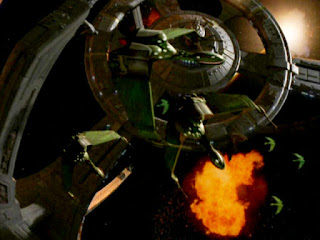Major Kira has a lead to the location of a ship of Bajoran prisoners that crashed and was lost years ago during the occupation. But she's forced to chase down this lead in the company of Dukat, who has a secret reason of his own for pursuing the ship. Meanwhile, Kasidy Yates and Benjamin Sisko broach the subject of moving in together... but his awkward reaction to the idea threatens the entire relationship.
Two freelancers brought the show this story inspired by the western The Searchers, and the script was assigned to Nicholas Corea (whose idea for "Hippocratic Oath" had also just been purchased -- but assigned to a different writer). It's a significant episode for Kira, and Nana Visitor gives an intense performance. Still, this is really a Dukat story, rounding him out as much as other far more sympathetic recurring characters like Rom or Keiko. He quotes a Bajoran Kai from memory. He admits to falling in love with a Bajoran woman, and fathering a child with her.
Still, Dukat doesn't come off that warm and fuzzy. He suggests that Bajorans benefited from the toughening up they received during the Cardassian Occupation. His love affair came while he was married to another woman. And his stated intention is to kill his illegitimate daughter when he finds her. His change of heart in that is suspect too; it's unclear how much of what he's doing is because he thinks it will impress Kira into having feelings for him.
By this point, Nana Visitor had repeatedly declared to the writers that she thought such a relationship impossible, finding a particular advocate in staff writer Robert Hewitt Wolfe, who agreed Kira would never consider a romance with Dukat even with a "gun to her head." Still, the writers found it fun to let Dukat think, for his part, that such a connection might be possible -- probably entertained by the swaggering gusto actor Marc Alaimo brought to the performance. He's certainly fun in moments, including the key scene in which he sits on a thorn, Kira briefly lets her guard down, and the two enjoy a true laugh that oh-so-briefly forgets who each of them are to one another.
That such a pure, natural moment appears in the episode may be a testament to having an actor as the director -- this was the first of several Deep Space Nine episodes directed by Next Generation actor LeVar Burton. This may not be the Star Trek series Burton was most familiar with, but he really seems to grasp the relationships here -- not just the adversarial one between Kira and Dukat, but a nice moment of friendship between Kira and Odo (who wishes the Major luck, against the odds).
Burton also injects both fun and honesty in the B plot involving Sisko and his "big step" with Kasidy Yates. Everyone from Dax to Bashir to Quark gets to weigh in on his poor choice of words. It all essentially comes down to Benjamin simply being wrong -- something William Shatner's ego would never have allowed for Kirk on the original series, nor would Gene Roddenberry's benevolent parent conception of Picard have allowed on The Next Generation. Sisko ultimately has a reason, though; he's nagged by fear over how he lost his wife Jennifer. Avery Brooks and Penny Johnson Jerald are both great in this episode, not only making the argument seem real, but reveling in the moments of playful banter too. (All is forgiven in the end, though Sisko pointedly does not receive a kiss.)
Other observations:
- Character actor Roy Brocksmith plays Kira's informant Razka Karn. Sci-fi fans may know him from Total Recall, while Star Trek fans will recognize him (despite the makeup, thanks largely to his distinctive voice) as Sirna Kolrami from The Next Generation's "Peak Performance."
- The filming on location for the crash site really adds a lot to this episode. Sure, Star Trek has visited this desert location several times, but it feels especially oppressive here -- no doubt because it was reportedly over 100 degrees during the filming.
- The Breen had been mentioned before on the show, but here we see them (or, at least, their "Princess Leia disguised as a bounty hunter" environmental suits) for the first time.




















